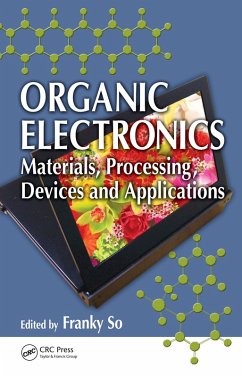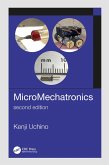Organic Electronics (eBook, ePUB)
Materials, Processing, Devices and Applications
Redaktion: So, Franky
186,95 €
186,95 €
inkl. MwSt.
Sofort per Download lieferbar

93 °P sammeln
186,95 €
Als Download kaufen

186,95 €
inkl. MwSt.
Sofort per Download lieferbar

93 °P sammeln
Jetzt verschenken
Alle Infos zum eBook verschenken
186,95 €
inkl. MwSt.
Sofort per Download lieferbar
Alle Infos zum eBook verschenken

93 °P sammeln
Organic Electronics (eBook, ePUB)
Materials, Processing, Devices and Applications
Redaktion: So, Franky
- Format: ePub
- Merkliste
- Auf die Merkliste
- Bewerten Bewerten
- Teilen
- Produkt teilen
- Produkterinnerung
- Produkterinnerung

Bitte loggen Sie sich zunächst in Ihr Kundenkonto ein oder registrieren Sie sich bei
bücher.de, um das eBook-Abo tolino select nutzen zu können.
Hier können Sie sich einloggen
Hier können Sie sich einloggen
Sie sind bereits eingeloggt. Klicken Sie auf 2. tolino select Abo, um fortzufahren.

Bitte loggen Sie sich zunächst in Ihr Kundenkonto ein oder registrieren Sie sich bei bücher.de, um das eBook-Abo tolino select nutzen zu können.
In the near future, organic semiconductors may be used in a variety of products, including flat-screen TVs, e-book readers, and third-generation organic photovoltaics applications, to name just a few. While organic electronics has received increased attention in scientific journals, those working in this burgeoning field require more in-depth cover
- Geräte: eReader
- mit Kopierschutz
- eBook Hilfe
Andere Kunden interessierten sich auch für
![Nanotechnology (eBook, ePUB) Nanotechnology (eBook, ePUB)]() Nanotechnology (eBook, ePUB)48,95 €
Nanotechnology (eBook, ePUB)48,95 €![Metamaterial for Microwave Applications (eBook, ePUB) Metamaterial for Microwave Applications (eBook, ePUB)]() Metamaterial for Microwave Applications (eBook, ePUB)48,95 €
Metamaterial for Microwave Applications (eBook, ePUB)48,95 €![Nanocrystals in Nonvolatile Memory (eBook, ePUB) Nanocrystals in Nonvolatile Memory (eBook, ePUB)]() Writam BanerjeeNanocrystals in Nonvolatile Memory (eBook, ePUB)265,95 €
Writam BanerjeeNanocrystals in Nonvolatile Memory (eBook, ePUB)265,95 €![Elements of Electromigration (eBook, ePUB) Elements of Electromigration (eBook, ePUB)]() King-Ning TuElements of Electromigration (eBook, ePUB)49,95 €
King-Ning TuElements of Electromigration (eBook, ePUB)49,95 €![Physical Models for Quantum Wires, Nanotubes, and Nanoribbons (eBook, ePUB) Physical Models for Quantum Wires, Nanotubes, and Nanoribbons (eBook, ePUB)]() Physical Models for Quantum Wires, Nanotubes, and Nanoribbons (eBook, ePUB)265,95 €
Physical Models for Quantum Wires, Nanotubes, and Nanoribbons (eBook, ePUB)265,95 €![MicroMechatronics, Second Edition (eBook, ePUB) MicroMechatronics, Second Edition (eBook, ePUB)]() Kenji UchinoMicroMechatronics, Second Edition (eBook, ePUB)52,95 €
Kenji UchinoMicroMechatronics, Second Edition (eBook, ePUB)52,95 €![Space Terahertz Remote Sensing Technology (eBook, ePUB) Space Terahertz Remote Sensing Technology (eBook, ePUB)]() Weidong HuSpace Terahertz Remote Sensing Technology (eBook, ePUB)157,95 €
Weidong HuSpace Terahertz Remote Sensing Technology (eBook, ePUB)157,95 €-
-
-
In the near future, organic semiconductors may be used in a variety of products, including flat-screen TVs, e-book readers, and third-generation organic photovoltaics applications, to name just a few. While organic electronics has received increased attention in scientific journals, those working in this burgeoning field require more in-depth cover
Dieser Download kann aus rechtlichen Gründen nur mit Rechnungsadresse in A, B, BG, CY, CZ, D, DK, EW, E, FIN, F, GR, HR, H, IRL, I, LT, L, LR, M, NL, PL, P, R, S, SLO, SK ausgeliefert werden.
Produktdetails
- Produktdetails
- Verlag: Taylor & Francis eBooks
- Seitenzahl: 581
- Erscheinungstermin: 24. November 2009
- Englisch
- ISBN-13: 9781040070154
- Artikelnr.: 72288914
- Verlag: Taylor & Francis eBooks
- Seitenzahl: 581
- Erscheinungstermin: 24. November 2009
- Englisch
- ISBN-13: 9781040070154
- Artikelnr.: 72288914
- Herstellerkennzeichnung Die Herstellerinformationen sind derzeit nicht verfügbar.
Franky So received his BA in physics from Hamilton College, his MS in materials science from the Massachusetts Institute of Technology, and his Ph.D in electrical engineering from the University of Southern California. After his graduation in 1991, he worked as a research scientist at the Hoechst Celanese Research Division studying high-speed polymer electro-optical modulators and organic light-emitting diodes (OLEDs). In 1993, he joined the Motorola Phoenix Corporate Laboratories working on OLEDs for flat-panel displays. He later became the program manager responsible for the development of OLED technology. During his tenure at Motorola, he received the Distinguished Innovator Award and the Master Innovator Award. In 2001, So joined OSRAM Opto-Semiconductors and became the head of materials and devices research. He was responsible for managing the OLED R&D activities for flat-panel displays as well as solid state lighting. In the summer of 2005, he joined the faculty in the Department of Materials Science and Engineering at the University of Florida. He currently works as an associate professor in the department. His research interests include electronic properties of organic semiconductor thin films, charge transport properties, device physics, organic-based light-emitting devices, organic photovoltaics, and organic sensors. Dr. So is currently an associate editor of the IEEE Journal of Display Technology and the journal Materials Science and Engineering Reports. Dr. So has more than 70 publications, holds more than 60 patents and is a Fellow of SPIE.
Part I: Materials and Processing
p-Conjugated Polymers for OLEDs. Organic Vapor-Phase Deposition.
Part II: Device Physics
Charge Transport and Injection in Amorphous Organic Semiconductors.
Magnetic Field Effects in Organic Semiconducting Materials and Devices.
Interface in Organic Semiconductor Devices: Dipole, Doping, Band Bending,
and Growth. Interfaces in Organic Electronic Devices-New Insights to
Traditional Concepts. The Role of Homolytic Reactions in the Intrinsic
Degradation of OLEDs. Materials and Interface Engineering in Organic
Light-Emitting Diodes.
Part III: Organic Electronic Devices
Microcavity Effects in Organic Light-Emitting Devices. Vertical-Type
Organic Transistors. Routes toward High-Efficiency Polymer Solar Cells.
Mixed Molecular Heterojunction Photovoltaic Cells.Development of Polymer
Semiconductors for Field-Effect Transistor Devices in Displays.
Part IV: Applications
OLED Materials and Device Architectures for Full-Color Displays and
Solid-State Lighting. Organic Light-Emitting Diodes and Photodetectors for
Optical Communication.
Part I: Materials and Processing
p-Conjugated Polymers for OLEDs. Organic Vapor-Phase Deposition.
Part II: Device Physics
Charge Transport and Injection in Amorphous Organic Semiconductors.
Magnetic Field Effects in Organic Semiconducting Materials and Devices.
Interface in Organic Semiconductor Devices: Dipole, Doping, Band Bending,
and Growth. Interfaces in Organic Electronic Devices-New Insights to
Traditional Concepts. The Role of Homolytic Reactions in the Intrinsic
Degradation of OLEDs. Materials and Interface Engineering in Organic
Light-Emitting Diodes.
Part III: Organic Electronic Devices
Microcavity Effects in Organic Light-Emitting Devices. Vertical-Type
Organic Transistors. Routes toward High-Efficiency Polymer Solar Cells.
Mixed Molecular Heterojunction Photovoltaic Cells.Development of Polymer
Semiconductors for Field-Effect Transistor Devices in Displays.
Part IV: Applications
OLED Materials and Device Architectures for Full-Color Displays and
Solid-State Lighting. Organic Light-Emitting Diodes and Photodetectors for
Optical Communication.
p-Conjugated Polymers for OLEDs. Organic Vapor-Phase Deposition.
Part II: Device Physics
Charge Transport and Injection in Amorphous Organic Semiconductors.
Magnetic Field Effects in Organic Semiconducting Materials and Devices.
Interface in Organic Semiconductor Devices: Dipole, Doping, Band Bending,
and Growth. Interfaces in Organic Electronic Devices-New Insights to
Traditional Concepts. The Role of Homolytic Reactions in the Intrinsic
Degradation of OLEDs. Materials and Interface Engineering in Organic
Light-Emitting Diodes.
Part III: Organic Electronic Devices
Microcavity Effects in Organic Light-Emitting Devices. Vertical-Type
Organic Transistors. Routes toward High-Efficiency Polymer Solar Cells.
Mixed Molecular Heterojunction Photovoltaic Cells.Development of Polymer
Semiconductors for Field-Effect Transistor Devices in Displays.
Part IV: Applications
OLED Materials and Device Architectures for Full-Color Displays and
Solid-State Lighting. Organic Light-Emitting Diodes and Photodetectors for
Optical Communication.
Part I: Materials and Processing
p-Conjugated Polymers for OLEDs. Organic Vapor-Phase Deposition.
Part II: Device Physics
Charge Transport and Injection in Amorphous Organic Semiconductors.
Magnetic Field Effects in Organic Semiconducting Materials and Devices.
Interface in Organic Semiconductor Devices: Dipole, Doping, Band Bending,
and Growth. Interfaces in Organic Electronic Devices-New Insights to
Traditional Concepts. The Role of Homolytic Reactions in the Intrinsic
Degradation of OLEDs. Materials and Interface Engineering in Organic
Light-Emitting Diodes.
Part III: Organic Electronic Devices
Microcavity Effects in Organic Light-Emitting Devices. Vertical-Type
Organic Transistors. Routes toward High-Efficiency Polymer Solar Cells.
Mixed Molecular Heterojunction Photovoltaic Cells.Development of Polymer
Semiconductors for Field-Effect Transistor Devices in Displays.
Part IV: Applications
OLED Materials and Device Architectures for Full-Color Displays and
Solid-State Lighting. Organic Light-Emitting Diodes and Photodetectors for
Optical Communication.
Part I: Materials and Processing
p-Conjugated Polymers for OLEDs. Organic Vapor-Phase Deposition.
Part II: Device Physics
Charge Transport and Injection in Amorphous Organic Semiconductors.
Magnetic Field Effects in Organic Semiconducting Materials and Devices.
Interface in Organic Semiconductor Devices: Dipole, Doping, Band Bending,
and Growth. Interfaces in Organic Electronic Devices-New Insights to
Traditional Concepts. The Role of Homolytic Reactions in the Intrinsic
Degradation of OLEDs. Materials and Interface Engineering in Organic
Light-Emitting Diodes.
Part III: Organic Electronic Devices
Microcavity Effects in Organic Light-Emitting Devices. Vertical-Type
Organic Transistors. Routes toward High-Efficiency Polymer Solar Cells.
Mixed Molecular Heterojunction Photovoltaic Cells.Development of Polymer
Semiconductors for Field-Effect Transistor Devices in Displays.
Part IV: Applications
OLED Materials and Device Architectures for Full-Color Displays and
Solid-State Lighting. Organic Light-Emitting Diodes and Photodetectors for
Optical Communication.
Part I: Materials and Processing
p-Conjugated Polymers for OLEDs. Organic Vapor-Phase Deposition.
Part II: Device Physics
Charge Transport and Injection in Amorphous Organic Semiconductors.
Magnetic Field Effects in Organic Semiconducting Materials and Devices.
Interface in Organic Semiconductor Devices: Dipole, Doping, Band Bending,
and Growth. Interfaces in Organic Electronic Devices-New Insights to
Traditional Concepts. The Role of Homolytic Reactions in the Intrinsic
Degradation of OLEDs. Materials and Interface Engineering in Organic
Light-Emitting Diodes.
Part III: Organic Electronic Devices
Microcavity Effects in Organic Light-Emitting Devices. Vertical-Type
Organic Transistors. Routes toward High-Efficiency Polymer Solar Cells.
Mixed Molecular Heterojunction Photovoltaic Cells.Development of Polymer
Semiconductors for Field-Effect Transistor Devices in Displays.
Part IV: Applications
OLED Materials and Device Architectures for Full-Color Displays and
Solid-State Lighting. Organic Light-Emitting Diodes and Photodetectors for
Optical Communication.
p-Conjugated Polymers for OLEDs. Organic Vapor-Phase Deposition.
Part II: Device Physics
Charge Transport and Injection in Amorphous Organic Semiconductors.
Magnetic Field Effects in Organic Semiconducting Materials and Devices.
Interface in Organic Semiconductor Devices: Dipole, Doping, Band Bending,
and Growth. Interfaces in Organic Electronic Devices-New Insights to
Traditional Concepts. The Role of Homolytic Reactions in the Intrinsic
Degradation of OLEDs. Materials and Interface Engineering in Organic
Light-Emitting Diodes.
Part III: Organic Electronic Devices
Microcavity Effects in Organic Light-Emitting Devices. Vertical-Type
Organic Transistors. Routes toward High-Efficiency Polymer Solar Cells.
Mixed Molecular Heterojunction Photovoltaic Cells.Development of Polymer
Semiconductors for Field-Effect Transistor Devices in Displays.
Part IV: Applications
OLED Materials and Device Architectures for Full-Color Displays and
Solid-State Lighting. Organic Light-Emitting Diodes and Photodetectors for
Optical Communication.
Part I: Materials and Processing
p-Conjugated Polymers for OLEDs. Organic Vapor-Phase Deposition.
Part II: Device Physics
Charge Transport and Injection in Amorphous Organic Semiconductors.
Magnetic Field Effects in Organic Semiconducting Materials and Devices.
Interface in Organic Semiconductor Devices: Dipole, Doping, Band Bending,
and Growth. Interfaces in Organic Electronic Devices-New Insights to
Traditional Concepts. The Role of Homolytic Reactions in the Intrinsic
Degradation of OLEDs. Materials and Interface Engineering in Organic
Light-Emitting Diodes.
Part III: Organic Electronic Devices
Microcavity Effects in Organic Light-Emitting Devices. Vertical-Type
Organic Transistors. Routes toward High-Efficiency Polymer Solar Cells.
Mixed Molecular Heterojunction Photovoltaic Cells.Development of Polymer
Semiconductors for Field-Effect Transistor Devices in Displays.
Part IV: Applications
OLED Materials and Device Architectures for Full-Color Displays and
Solid-State Lighting. Organic Light-Emitting Diodes and Photodetectors for
Optical Communication.







